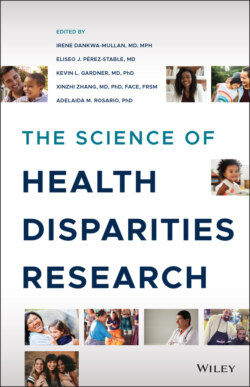Читать книгу The Science of Health Disparities Research - Группа авторов - Страница 60
3.5.3 Pittsburgh Hill/Homewood Research on Neighborhoods and Health Study
ОглавлениеThe Pittsburgh Hill/Homewood Research on Neighborhoods and Health (PHRESH) study evaluates a natural experiment of neighborhood revitalization on health in Black communities. To reduce inequalities in food access, policy solutions have concentrated on addressing the issue of “food deserts,” or neighborhoods with inadequate access to healthy, affordable foods. One proposal has been to place full‐service supermarkets in neighborhoods with limited access to healthy food. To better understand how this solution may lead to changes in diet, Dubowitz and colleagues conducted a rigorous study in Pittsburgh, PA that surveyed two predominately Black sociodemographically similar neighborhoods. The PHRESH study uses a quasi‐experimental longitudinal design. One of the study neighborhoods received a new supermarket, and the other acted as a control in order to understand if the introduction of the supermarket led to improved dietary outcomes. Data were collected using surveys with randomly selected residents, which included two 24‐hour dietary recalls administered between seven to fourteen days apart [29].
The study results showed net positive changes in overall dietary quality; average daily intakes of kilocalories and added sugars; and percentage of kilocalories from solid fats, added sugars, and alcohol in the neighborhood that received a full‐service supermarket [29]. However, the only positive outcome in the recipient neighborhood specifically associated with regular use of the new supermarket was improved perceived access to healthy food. The researchers did not observe a significant increase between the neighborhoods in fruit and vegetable intake, whole grain consumption, or body mass index. Though the introduction of supermarkets in food deserts is appropriate, the mechanisms for understanding how the introduction of such supermarkets may influence dietary behaviors and weight status requires further study. Policymakers considering the approach of introducing full‐service supermarkets in food deserts should include assessments of other community‐level mechanisms that may affect both store users and nonusers. Finally, future assessments should consider longer‐term follow‐ups, which may allow for changes in weight status to be detected [29].
Another PHRESH study examined neighborhood walkability. Previous studies have found that Black adults are not likely to get the recommended amount of daily moderate to vigorous physical activity (MVPA) [30], which is known to be an important factor for lowering diastolic blood pressure [31] and for reducing the risk of cardiovascular disease and risk factors [32]. In a study conducted by Richardson and colleagues using data from the PHRESH study, it was hypothesized that low levels of MVPA (where accelerometry was used to measure physical activity, which is superior to self‐reporting) among Black adults may be associated with crime rates, the amount of green space, and walkability in one's neighborhood [30]. In addition to data from PHRESH, the study examined crime data available from the City of Pittsburgh and used ArcGIS to calculate street network distances from households to crime locations. The team hypothesized that crime occurring in the previous year would influence perceptions of safety. The team studied the relationship between these three variables (i.e., neighborhood green space, walkability, and crime) and their influence on MVPA, as well as a potential interaction effect.
The results suggested that, although all residents engaged in little MVPA, women under the age of 65 living in more walkable neighborhoods engaged in significantly more MVPA. The variables green space and crime were not associated with MVPA in this study. However, there may have been limited power to detect associations between neighborhood characteristics and MVPA. Future studies are required to increase knowledge regarding the impact of lifestyle and neighborhood factors (e.g., walkability, green space, and crime) and their interactions on MVPA to inform public health policy [30].
